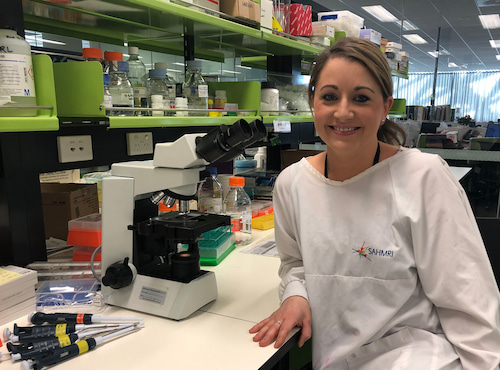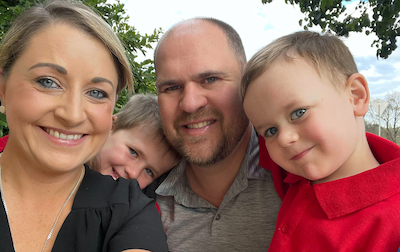Identifying high-risk smouldering myeloma to improve patient outcomes
Each year, one in every 10 people with a diagnosis of smouldering myeloma will progress to myeloma but there is no way to determine who these patients will be.
Or the other nine patients who will remain in the smouldering myeloma (SM) stage.

Dr Melissa Cantley hopes to change that through her research which is aimed at identifying these different patient groups within the smouldering myeloma cohort; those likely to progress to myeloma and those at low risk of their disease progressing.
Her overall goal is to have a simple blood test that allows SM patients to be informed about their risk of developing myeloma.
Dr Cantley’s research is supported by the Leukaemia Foundation. In 2020, she received a Priority-driven Collaborative Cancer Research Scheme (PdCCRS) in collaboration with Cancer Australia; $200,000 over two years.
Dr Cantley is chief investigator (CI) of the project, Using novel high-precision proteomic analysis to discover biomarkers that identify smouldering myeloma patients at high-risk of progression to active multiple myeloma.
“We are using state-of-the-art proteomic analysis to identify markers in the blood of patients with smouldering myeloma who are at high risk and will rapidly go on to develop myeloma, so we can look at giving them early treatment to give them the best chance of survival,” said Dr Cantley, who is based at the University of Adelaide’s Myeloma Research Laboratory at the South Australian Health and Medical Research Institute.
What is smouldering myeloma?
In active myeloma, patients have high numbers of abnormal cancerous plasma cells in their bone marrow usually with associated organ damage in their bones and kidneys, or other symptoms like anaemia. Often in these patients, clinical symptoms (evidence of organ damage such as tiredness due to anaemia or breaking a bone after a fall) caused them to go to their doctor, and then they are diagnosed with myeloma.
Dr Cantley describes SM as a precancerous condition where patients have abnormal myeloma plasma cells present in their bone marrow but they do not show signs of clinical symptoms.
“These abnormal myeloma cells are not present at high enough levels to be causing organ damage including hypercalcaemia, anaemia, renal problems or lytic bone lesions (holes in the bone) that is seen in myeloma,” explained Dr Cantley.
In many cases, a diagnosis of smouldering myeloma is an incidental finding when the M protein (a protein produced by myeloma cells, also known as myeloma protein or paraprotein) is detected in the blood, after a routine blood test.
“You can see the M protein in these patients but they’re not at the stage of being diagnosed with myeloma because they don’t have the presence of high tumour burden or organ damage,” said Dr Cantley.
“These patients go on a watch and wait protocol, where they are monitored closely by a haematologist for any evidence of progression.
“There’s quite a range of progression within patients with smoldering myeloma.”
“Some will rapidly progress to develop myeloma within two years of diagnosis, and others will remain stable for an extended period of time. They’ll just stay with their smouldering myeloma diagnosis for 10 years plus.
“And some patients will never go on to develop myeloma.”

Importance of identifying high-risk and low-risk patients with smouldering myeloma
“A big focus of our research is trying to understand if we can identify those patients who are really quickly going to go on to develop myeloma, so we can give them the best chance of survival by giving them the ability to have treatment earlier,” said Dr Cantley.
“At the moment, we don’t know how to effectively identify which patients will rapidly progress, and they are the ones who would really benefit from having early treatment.
“We’re talking about treatment options [chemotherapy and bone marrow transplantation] that have quite a number of side effects.
“We really want to know who these patients are that will go on to develop myeloma really rapidly, to give them best chance of survival.
“And, if we can identify those patients who are at a low risk, then we can provide them with a bit of reassurance that they’re not at a high risk of developing myeloma in the short-term,” said Dr Cantley.
A range of different factors are involved in driving disease progression, not simply one factor, so it is difficult to try to predict the risk of developing myeloma within two years of a smouldering myeloma diagnosis.
“At the moment, several different methods are used which combine different risk factors together to give a risk level for a patient. It’s not really definitive,” explained Dr Cantley.
“There’s a lot of research interest in identifying the high-risk patients and there are clinical trials in the U.S. testing the effects of treating smouldering myeloma patients, to see whether they have an improved chance of survival.
“Preliminary evidence suggests that treating during the smouldering myeloma stage has a benefit in those patients that are at a high risk of progressing to myeloma, however, it’s still very much in the early stages. We need to do more work to understand the rationales and benefits of treating in the smouldering myeloma stage.
“We really need that knowledge.”
Collaborating nationally and internationally
Dr Cantley is undertaking her research in Professor Andrew Zannettino’s Myeloma Research Laboratory in Adelaide alongside Dr Kate Vandyke, a mid-career researcher like Dr Cantley, who also has a PdCCRS grant from the Leukaemia Foundation.
Dr Cantley is collaborating with an associate investigator from Monash University, as well as the associate investigators in the UK and U.S.
“Restrictions due to the COVID-19 pandemic have delayed the start of this project by several months, so we’re still in the early stages with our international collaborators,” said Dr Cantley.
“Two associate investigators on our grant are proteomic* experts who we are working with.
“We’re using smouldering myeloma samples collected locally through the South Australian Cancer Research Biobank.
“These samples are from patients we classify as low risk as they have remained stable for an extended period of time, and patients who are at high risk,” said Dr Cantley.
“We’ll be analysing them in the U.S. using this high-precision proteomic assessment to try and detect novel proteins (biomarkers) within the blood that are unique to those high-risk patients.
“What we’re looking at are the differences between those high-risk and the low-risk patients.”
Dr Cantley said initial results from this research will be available within the next six to 12 months from the first round of discovery on the proteins that are found to be unique.
“Once we’ve identified these proteins, we’ll investigate them a bit further using other methodologies to make sure that we can detect them and confirm that they are unique to those high-risk patients.
“Then we go on to try and validate it in a bigger cohort of patient samples in the second stage,” she said.
“The long-term aim is to develop that into a minimally-invasive test where we can use blood samples from patients, look at the levels of these proteins, and use them to predict whether a smouldering myeloma patient will be at high risk of going on to develop myeloma within two years of diagnosis.
“This may provide a rationale for why they might be best to start on earlier treatment.”
“It will also enable us to reassure those that are low risk and likely to remain stable for an extended period of time, that they can just have a wait and watch strategy, and that would be appropriate for them.”
How a Leukaemia Foundation grant is helping further research
Commenting on the effect of the Leukaemia Foundation’s funding support for her research, Dr Cantley said, “it’s had a major impact on my research to get a grant as CI at my early stage of career”.
“It helps me make accomplishments in the myeloma field by helping provide great results and data for understanding and identifying a high-risk patient cohort.
“And personally, it builds my track record and makes me more competitive to obtain future grant funding to be able to continue this work to understand this precancerous stage and how we can improve patient survival.”
* Proteomic analysis (proteomics) is the systematic identification and quantification of the complete complement of proteins (the proteome) of a biological system, in this case blood, at a specific point in time.
Melissa Cantley’s background
“My background in research is in the bone and joint field,” said Dr Cantley.
Her PhD work was in bone loss diseases like periodontal disease and rheumatoid arthritis, “trying to identify new treatments to target the bone loss cells (osteoclasts)”.
“My interest in myeloma spanned from the fact that up to 80% of patients with myeloma experience myeloma bone disease, where they get punched-out bone lesions which cause pain and increased risk of fracture.
“Osteoclasts play an important role in this myeloma bone disease and I was really interested in investigating them in the myeloma space.
“When I first entered this field, I was blown away by the fact that patients with myeloma are treated when they have evidence of clinical symptoms.
“There’s definitely the potential to intervene before they actually develop myeloma.
“I received a NHMRC Early Career Fellowship in 2014 that allowed me to join the Myeloma Research Lab at the University of Adelaide.
“I’ve had a number of years of career disruptions. I have two young children, so have taken maternity leave and worked part-time, over the last five years,” said Dr Cantley whose two sons are aged four and five.”
Last updated on February 22nd, 2022
Developed by the Leukaemia Foundation in consultation with people living with a blood cancer, Leukaemia Foundation support staff, haematology nursing staff and/or Australian clinical haematologists. This content is provided for information purposes only and we urge you to always seek advice from a registered health care professional for diagnosis, treatment and answers to your medical questions, including the suitability of a particular therapy, service, product or treatment in your circumstances. The Leukaemia Foundation shall not bear any liability for any person relying on the materials contained on this website.